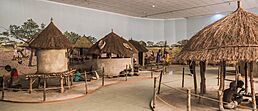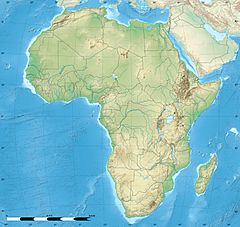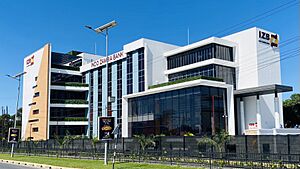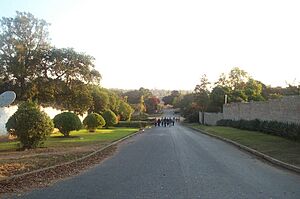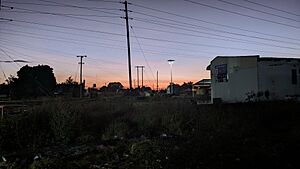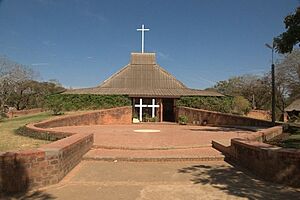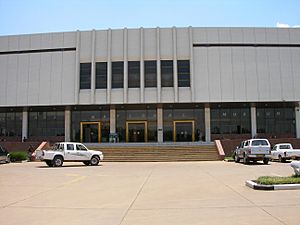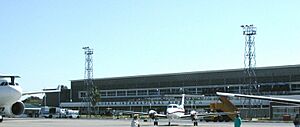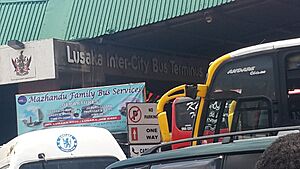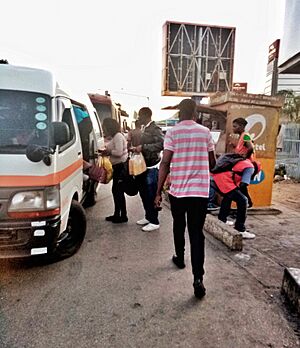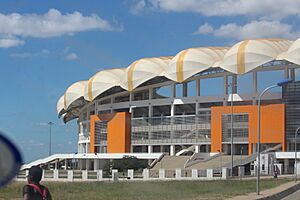Lusaka facts for kids
Quick facts for kids
Lusaka
Mwalusaka
|
|
|---|---|
|
From top and left to right: Central business district of Lusaka with FINDECO House visible; Kafue Roundabout and surroundings, University of Zambia Main Campus, Cathedral of the Holy Cross, ZANACO head office, Society Business Park, Cairo Mall, Lusaka National Museum exhibition
|
|
| Nickname(s):
LSK
|
|
| Country | |
| Province | Lusaka Province |
| District | Lusaka District |
| Established | 1905 |
| City status | 25 August 1960 |
| Government | |
| • Type | Mayor-council government |
| Area | |
| • Capital city | 360 km2 (140 sq mi) |
| Elevation | 1,279 m (4,190 ft) |
| Population
(2010 Census)
|
|
| • Capital city | 1,747,152 |
| • Estimate
(2020)
|
2,731,696 |
| • Density | 4,850/km2 (12,570/sq mi) |
| • Metro | 2,238,569 |
| Demonym(s) | Lusakan |
| Time zone | UTC+02:00 (Central Africa Time) |
| • Summer (DST) | (Not Observed) |
| Area code(s) | 0211 |
| HDI (2018) | 0.664 Medium |
Lusaka is the capital and largest city of Zambia. It is one of the fastest-growing cities in southern Africa. Lusaka is located in the southern part of a central plateau, about 1,279 meters (4,190 feet) above sea level. In 2019, the city's population was around 3.3 million people.
Lusaka is the main center for business and government in Zambia. It connects to the country's four major highways. These roads lead north, south, east, and west. English is the official language used by the city government. However, Bemba and Nyanja are the languages most commonly spoken on the streets.
The first signs of people living in this area date back to the 6th century AD. The first known village was built around the 11th century. Later, the Lenje and Soli peoples lived here from the 17th or 18th century.
The modern city of Lusaka began in 1905. At that time, it was part of the British protectorate of Northern Rhodesia. This area was controlled by the British South African Company (BSAC). The BSAC built a railway to connect their mines to Cape Town. Lusaka was chosen as a water stop along this railway line. It was named after a local Lenje chief called Lusaaka.
White farmers then settled in the area. They helped Lusaka grow into an important trading center. In 1929, the British colonial government decided to move its capital from Livingstone to a more central place. Lusaka was chosen as the new capital. Town planners helped design the city, which was built over many years.
Lusaka became the capital of newly independent Zambia in 1964. After this, many new buildings were constructed. These included government offices, the University of Zambia, and a new airport. Many people moved to Lusaka from other parts of Zambia. This led to the growth of many unplanned neighborhoods on the city's edges.
Contents
History of Lusaka
Early Settlements
The earliest signs of people living near Lusaka are from the 6th century. The first known village was built around the 11th century. It had round huts and was near where the Olympia suburb is today. Over the centuries, different groups of people moved in and out of the area. The Lenje and Soli peoples arrived in the 17th or 18th century.
Modern Lusaka sits on the border of these two groups' lands. The Lenje lived to the north, and the Soli to the south. In the 19th century, slave traders came to the area. They took people from the Soli and Lenje communities. Because of these attacks and their farming methods, the Soli and Lenje often moved. This meant there were no large, permanent towns.
British Influence and Railway
In the late 1800s, a British businessman named Cecil Rhodes started the British South African Company (BSAC). This company was given permission by Queen Victoria to take control of land in parts of southern Africa. Rhodes wanted to build a railway from Cape Town to Cairo. Even after he died in 1902, his company kept expanding north.
The BSAC took control of the Lusaka area in 1899. This region was called Barotziland–North-Western Rhodesia. The capital was first in Kalomo, then moved to Livingstone in 1907. In 1911, it merged with another territory to form Northern Rhodesia, which is now Zambia.
To help their mining interests, the BSAC built a railway north from South Africa. Lusaka was founded in 1905 as a water stop on this railway. It was named after a local chief, Lusaaka. White farmers settled in the area, and Lusaka became their main center. By 1913, it had stores and a hotel. The farmers convinced the BSAC to make Lusaka a recognized town.
After World War I, the British government took direct control of Northern Rhodesia in 1924. They wanted to build planned towns to show their authority.
Becoming the Capital City
In 1929, the British government decided to move the capital of Northern Rhodesia. They chose Lusaka because it was on the railway and at the crossing of two main roads. A town planner named Stanley Adshead was hired to design the new capital. He decided Lusaka was a good spot.
However, progress was slow due to the Great Depression in the 1930s. Many people came to Lusaka looking for construction work, but there wasn't any. This led to poverty and unrest. In 1934, Prince George visited Lusaka. He laid the foundation stone for the administrative buildings.
Lusaka officially became the capital in May 1935. All government officials were moved from Livingstone to Lusaka by a special train. Adshead's original plan for Lusaka was for it to be only an administrative center. It was not meant to have much industry or a large African population. However, later plans included areas for businesses and industries. The city was designed with separate areas for different groups of people.
Growth and Independence
Building Lusaka continued through the late 1930s, but money was short. During World War II, the copper industry grew, bringing more money to the government. This also led to more people moving to cities. Lusaka's population grew rapidly.
In 1948, a new law allowed permanent residential areas for Africans. The city built new suburbs like New Chilenje and Matero. However, many people still lived in informal settlements.
In 1953, Northern Rhodesia merged with its neighbors to form the Federation of Rhodesia and Nyasaland. Lusaka remained the capital of Northern Rhodesia, but many government offices moved to Salisbury (now Harare). This caused Lusaka's economy to suffer. However, the city's population kept growing as more people moved from rural areas to the informal settlements.
Capital of Zambia
By the late 1950s, new African leaders wanted majority rule and independence for Northern Rhodesia. After protests led by Kenneth Kaunda's party, the UK government agreed to a new constitution. In 1964, Northern Rhodesia became independent as the Republic of Zambia. Lusaka was named the capital.
A huge building program followed. New government buildings, the University of Zambia, and a new airport were built. These new jobs attracted even more people to Lusaka, making the housing shortage worse. The government built some new housing estates, but most people still lived in informal settlements.
Lusaka became a center for groups fighting for independence in other southern African countries. In 1969, African leaders met in Lusaka and created the Lusaka Manifesto. This document called for peaceful ways to achieve majority rule in southern Africa.
In the 1970s, Zambia's economy faced challenges due to falling copper prices. This led to fewer jobs in Lusaka. However, the city's population continued to grow due to natural growth and people moving from other parts of Zambia.
In the 2000s, Zambia's economy grew again. The government started projects to improve housing and services in Lusaka. However, many people still live in unplanned settlements. The city council is working on improving roads to help with traffic.
Lusaka's Geography
Zambia's land is mostly a high plateau with some hills. Lusaka is on this plateau in south-central Zambia. It is about 1,280 meters (4,190 feet) high. The city is about 472 kilometers (293 miles) northeast of Livingstone. It is also 362 kilometers (225 miles) from Kitwe, Zambia's second-largest city.
The city of Lusaka is the same as Lusaka District. It is also the capital of Lusaka Province, which is Zambia's smallest but most populated province.
The ground in Lusaka is made of different types of rock. These rocks allow more groundwater to collect than other parts of Zambia. The city is on a drainage divide. This means water in the northeast flows into the Chongwe River, while water in the west and south flows into the Kafue River. Both rivers eventually flow into the Zambezi River.
City Layout
Lusaka's main business area is around Cairo Road. This is where the original colonial town was founded. Cairo Road is a long, busy street with office buildings, shops, and cafes. Large trucks are not allowed on Cairo Road. West of Cairo Road are two big markets: the Central Market and New City Market.
East of the business area is the government area. This includes the State House and various government offices. Woodlands is a wealthy residential area for rich people and foreigners. Other wealthy areas are Ibex Hill and Rhodes Park.
However, most Lusaka residents live in unplanned neighborhoods. These are mostly in the west, south, and north of the city. Examples include Matero, Chilenje, and Libala.
Along Great East Road, you'll find three of Zambia's largest shopping malls: Arcades, East Park, and Manda Hill. The Sun Share Tower, a tall building, is also nearby.
Important places and symbols in Lusaka include the National Museum, the Freedom Statue, and a memorial for the victims of the 1993 Zambia national football team plane crash.
Climate
Lusaka has a humid subtropical climate. This is mainly because of its high altitude. The coldest month is July, with an average temperature of 14.9°C (58.8°F). Lusaka has hot summers and cool winters. Cold weather mostly happens at night in June and July. The hottest month is October, with daily high temperatures around 32°C (90°F).
There are three main seasons:
- A warm rainy season from November to March.
- A dry winter from April to August.
- A hot summer in September and October.
| Climate data for Lusaka City Airport (1991–2020) | |||||||||||||
|---|---|---|---|---|---|---|---|---|---|---|---|---|---|
| Month | Jan | Feb | Mar | Apr | May | Jun | Jul | Aug | Sep | Oct | Nov | Dec | Year |
| Record high °C (°F) | 35.1 (95.2) |
34.4 (93.9) |
34.2 (93.6) |
33.2 (91.8) |
31.1 (88.0) |
32.6 (90.7) |
31.1 (88.0) |
33.5 (92.3) |
37.6 (99.7) |
37.2 (99.0) |
39.5 (103.1) |
38.0 (100.4) |
39.5 (103.1) |
| Mean daily maximum °C (°F) | 26.9 (80.4) |
26.8 (80.2) |
27.2 (81.0) |
26.7 (80.1) |
25.4 (77.7) |
23.6 (74.5) |
26.1 (79.0) |
29.8 (85.6) |
31.5 (88.7) |
31.5 (88.7) |
30.4 (86.7) |
27.6 (81.7) |
27.8 (82.0) |
| Daily mean °C (°F) | 22.1 (71.8) |
21.9 (71.4) |
22.0 (71.6) |
21.0 (69.8) |
19.2 (66.6) |
17.3 (63.1) |
18.3 (64.9) |
21.3 (70.3) |
23.6 (74.5) |
24.8 (76.6) |
24.4 (75.9) |
22.5 (72.5) |
21.5 (70.7) |
| Mean daily minimum °C (°F) | 17.3 (63.1) |
17.0 (62.6) |
16.9 (62.4) |
15.3 (59.5) |
13.0 (55.4) |
10.9 (51.6) |
10.5 (50.9) |
12.7 (54.9) |
15.8 (60.4) |
18.1 (64.6) |
18.3 (64.9) |
17.5 (63.5) |
15.3 (59.5) |
| Record low °C (°F) | 8.6 (47.5) |
7.1 (44.8) |
7.5 (45.5) |
5.5 (41.9) |
5.9 (42.6) |
5.0 (41.0) |
3.0 (37.4) |
5.6 (42.1) |
6.0 (42.8) |
9.2 (48.6) |
10 (50) |
9.6 (49.3) |
3.0 (37.4) |
| Average precipitation mm (inches) | 209.7 (8.26) |
168.7 (6.64) |
87.6 (3.45) |
20.7 (0.81) |
2.7 (0.11) |
0.2 (0.01) |
0.0 (0.0) |
0.0 (0.0) |
0.3 (0.01) |
10.9 (0.43) |
78.0 (3.07) |
178.6 (7.03) |
757.5 (29.82) |
| Source: NOAA | |||||||||||||
| Climate data for Lusaka (Kenneth Kaunda International Airport) (1991–2020) | |||||||||||||
|---|---|---|---|---|---|---|---|---|---|---|---|---|---|
| Month | Jan | Feb | Mar | Apr | May | Jun | Jul | Aug | Sep | Oct | Nov | Dec | Year |
| Record high °C (°F) | 39.6 (103.3) |
36.4 (97.5) |
34.0 (93.2) |
34.1 (93.4) |
32.8 (91.0) |
30.9 (87.6) |
33.2 (91.8) |
33.5 (92.3) |
38.5 (101.3) |
38.9 (102.0) |
39.4 (102.9) |
36.7 (98.1) |
39.6 (103.3) |
| Mean daily maximum °C (°F) | 27.7 (81.9) |
28.1 (82.6) |
27.0 (80.6) |
27.8 (82.0) |
26.8 (80.2) |
25.0 (77.0) |
23.7 (74.7) |
27.5 (81.5) |
30.7 (87.3) |
29.1 (84.4) |
30.2 (86.4) |
26.9 (80.4) |
27.5 (81.6) |
| Daily mean °C (°F) | 22.9 (73.2) |
23.1 (73.6) |
22.1 (71.8) |
21.2 (70.2) |
19.0 (66.2) |
16.8 (62.2) |
15.9 (60.6) |
19.1 (66.4) |
22.3 (72.1) |
22.7 (72.9) |
24.3 (75.7) |
22.6 (72.7) |
21.4 (70.5) |
| Mean daily minimum °C (°F) | 18.2 (64.8) |
18.0 (64.4) |
17.3 (63.1) |
14.5 (58.1) |
11.2 (52.2) |
8.6 (47.5) |
8.1 (46.6) |
10.6 (51.1) |
14.0 (57.2) |
16.4 (61.5) |
18.3 (64.9) |
18.2 (64.8) |
14.5 (58.1) |
| Record low °C (°F) | 10.2 (50.4) |
7.5 (45.5) |
10.0 (50.0) |
8.0 (46.4) |
5.4 (41.7) |
0.2 (32.4) |
0.7 (33.3) |
2.8 (37.0) |
5.8 (42.4) |
8.1 (46.6) |
10.0 (50.0) |
10.1 (50.2) |
0.2 (32.4) |
| Average precipitation mm (inches) | 187.1 (7.37) |
143.4 (5.65) |
86.8 (3.42) |
24.7 (0.97) |
3.5 (0.14) |
0.0 (0.0) |
0.0 (0.0) |
0.2 (0.01) |
1.3 (0.05) |
8.6 (0.34) |
81.0 (3.19) |
192.6 (7.58) |
729.4 (28.72) |
| Average precipitation days (≥ 1.0 mm) | 18 | 15 | 10 | 3 | 0 | 0 | 0 | 0 | 0 | 2 | 8 | 16 | 72 |
| Average relative humidity (%) | 82.3 | 82.5 | 80.7 | 75.8 | 69.3 | 65.2 | 61.1 | 53.6 | 46.3 | 48.6 | 60.2 | 78.6 | 67.0 |
| Mean monthly sunshine hours | 176.7 | 168.0 | 220.1 | 246.0 | 275.9 | 270.0 | 294.5 | 303.8 | 291.0 | 272.8 | 234.0 | 182.9 | 2,935.7 |
| Source: NOAA (precipitation days, humidity, sun 1961-1990) | |||||||||||||
People of Lusaka
In 2010, Lusaka's population was over 1.7 million people. It has continued to grow quickly, reaching an estimated 2.7 million in 2020. Lusaka does not have one main ethnic group. People from all of Zambia's different groups live here. This is because many people have moved to the city from all over the country. The government also has a "One Zambia, One Nation" policy. This encourages government workers to work anywhere in the country.
Most of the people are of African origin. However, there are also long-term residents who are not of Bantu origin. These include white people, many of whom are descendants of early settlers. There are also many Gujarati-speaking Indians. Many of these non-Bantu residents are Zambian citizens.
Languages Spoken
Like the rest of Zambia, English is the official national language in Lusaka. It is used in schools from fifth grade and in universities. English is also used by large businesses, most newspapers, and the government.
The local language spoken in the city until the late 1980s was Nyanja. This language was brought by people who moved from Eastern Province. Since then, more people have moved from the Copperbelt region. This has led to more use of Bemba among city residents.
The mix of these languages has created a new language in Lusaka called Town Nyanja. It is based on Nyanja but includes words from English, Bemba, and Nsenga.
Education in Lusaka
Zambia's oldest and largest learning institution is the University of Zambia. It is located in Lusaka and opened in 1966. Many other universities and colleges are also in Lusaka. Some of these include the University of Lusaka (UNILUS) and Evelyn Hone College.
Lusaka has some of the best schools in Zambia. These include the American International School of Lusaka, Rhodes Park School, and the Lusaka International Community School. There are also international schools for French, Italian, and Chinese students. Some well-known local schools are Matero Boys' Secondary School and Roma Girls' Secondary School.
Places of Worship
Lusaka has many places of worship. Most of these are Christian churches. These include the Roman Catholic Archdiocese of Lusaka, the Anglican Cathedral of the Holy Cross, and the United Church in Zambia. There are also several large mosques for the local Muslim community.
Culture and Attractions
Some popular attractions in Lusaka include:
- The Lusaka National Museum
- The Zintu Community Museum
- The Freedom Statue
- The Zambian National Assembly
- The Agricultural Society Showgrounds (known for their annual agricultural show)
- The Lusaka Playhouse theatre
- The National Heroes Stadium
- Kalimba Reptile Park
- Munda Wanga Environmental Park (with a zoo and botanical gardens)
Lusaka's Economy
Lusaka is the main economic and financial hub of Zambia. It is the country's largest business center and main gateway to the rest of the world. In 2014, Lusaka Province had the second-highest gross domestic product in Zambia. It contributed 27.2 percent of the country's total output.
Unlike Zambia as a whole, where farming and mining are biggest, Lusaka's economy is mostly based on services. This includes wholesale and retail trade. Major job areas in the city are finance, insurance, real estate, transport, and construction. The main offices of Zambian banks are in Lusaka. The Lusaka Stock Exchange, which started in 1993, is also here.
Shopping Centers
Lusaka has the most and largest shopping centers in Zambia. These include:
- Manda Hill
- Levy Junction
- EastPark
- Cosmopolitan
- Arcade Shopping Centre
Newer malls like Lewanika shopping mall and Novare Pinnacle malls have also been built.
Transportation
Lusaka has two airports. Kenneth Kaunda International Airport is used for both civilian and military flights. Lusaka City Airport is used by the Zambian Air Force.
The city is served by the Cape to Cairo Railway (Zambia Railways). This railway connects Lusaka to cities like Kabwe and Ndola in the north. It also connects to Livingstone and Bulawayo in the south. The international airport is also connected to the railway.
Lusaka is crossed by two major highways:
- Trans-African Highway 9 (TAH 9): Connects Lusaka to Harare and Lubumbashi.
- Trans-African Highway 4 (TAH 4): Connects Lusaka to Dodoma and Bulawayo.
Lusaka's city center is where three major roads meet:
- The Great North Road (T2)
- The Great East Road (T4)
- The Mongu Road (M9)
Public transport within the city is mainly by minibuses. There are also larger buses and shared taxis. Most routes travel between different parts of the city and four main terminals in the central business district. All public transport in Lusaka is run by private companies.
Healthcare Services
Zambia has five national hospitals that provide specialized care. Two of these are in Lusaka. The largest is the University Teaching Hospital (UTH). It has many beds and serves about 2 million people. UTH is also the main place for training doctors and nurses in Zambia. Lusaka's second specialized hospital is Chainama Hills. It is Zambia's only psychiatric hospital.
In 2007, Lusaka had 34 government-run health centers and 134 private ones. The government aims to provide universal health care (UHC) for all Zambians. As of 2017, basic health care was free, but services were sometimes limited. The Ministry of Health is working with a Japanese agency to improve healthcare.
Sports in Lusaka
The biggest sports place in Lusaka is National Heroes Stadium. It was built with help from China and opened in 2014. It can hold 60,000 people. The stadium is named after those who died in the 1993 Zambia national football team plane crash.
The stadium is used for home matches of the Zambian national football team. It also hosted games for the 2017 Africa U-20 Cup of Nations. Zambia won that tournament at the National Heroes Stadium. The stadium is also used for athletics events.
As of 2021, six of the eighteen teams in Zambia's top football league are from Lusaka. The city's most successful club is Zanaco F.C., which has won seven national titles. Another successful team is Green Buffaloes F.C.. Besides National Heroes Stadium, Lusaka's football teams play at Nkoloma Stadium and Sunset Stadium.
Lusaka is also home to the basketball team UNZA Pacers, which is part of the University of Zambia.
Sister Cities
Lusaka is connected with these cities around the world:
 Dushanbe, Tajikistan, since 1966
Dushanbe, Tajikistan, since 1966 Beirut, Lebanon, (2018)
Beirut, Lebanon, (2018) Udon Thani, Thailand, (2015)
Udon Thani, Thailand, (2015) Los Angeles, United States, since 1968
Los Angeles, United States, since 1968 Izhevsk, Russia
Izhevsk, Russia
Famous People from Lusaka
- The rugby players Corné Krige and George Gregan were both born in Lusaka. They captained the South African and Australian teams.
- The former Zimbabwe cricketer Henry Olonga was also born in Lusaka. He was the first black cricketer to play for Zimbabwe.
- Lusaka is the hometown of Joseph and Luka Banda. They were the first conjoined twins to be successfully separated by Dr. Ben Carson.
- Former professional footballer Enock Mwepu was born in Lusaka.
- Zambian model Lukundo Nalungwe grew up in Lusaka.
- Chilufya Tayali, a Zambian politician, lives in Lusaka.
- Vaughan Gething, the First Minister of Wales, was born in Lusaka.
Images for kids
-
Government House, built for the Governor of Northern Rhodesia
See also
 In Spanish: Lusaka para niños
In Spanish: Lusaka para niños









